30 October 2005
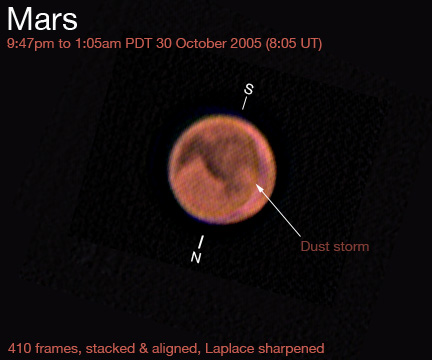
Well, this is just about as close as it's gonna get. I caught a bit of the dust storm, as compared with other astronomers. And is that arc along the right-hand side an artifact of the optics, or atmospheric on Mars? Looking at this Sky & Telescope image, I'm thinking it might be in Mars' atmosphere, but it could easily be a result of the sharpening, or stacking, or reflections in the optics.
23 October 2005
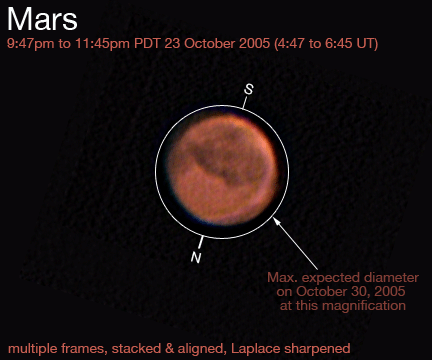
Each image is about 15-30 minutes apart. Each frame is 100+ individual frames stacked. There's a hint of the dust storm in the upper right. And the South polar cap is showing up at least a little.
22 October 2005
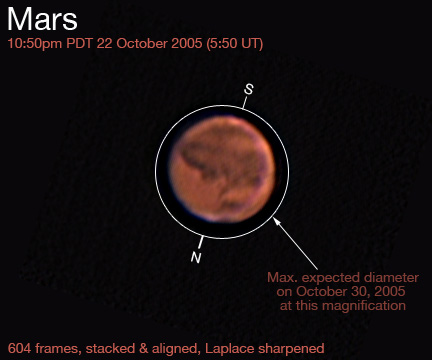
This is the best Mars has been yet. Looks like a bit of the North polar hood is showing.
16 October 2005
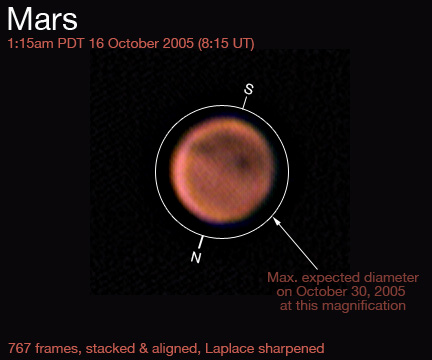
Well, it's bigger, but it's not quite as clear (and it's not the "interesting" side). The moon is nearly full, which may be part of it. Also, the atmosphere was pretty disturbed last night.
28 September 2005
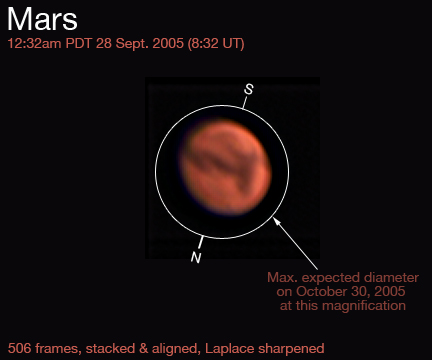
Mars, 12:32am 9/28/05 304 frames aligned, stacked & Laplace sharpened
I made a small change to the webcam - adding a cone of black paper inside it to shield the CCD from the yellow LED. I don't know if that's why the image turned out better, or if it was just a slightly steadier atmosphere tonight. I also cleaned off the glass front of the scope, which might have helped a bit. Oh, and I took off the filter from the webcam, so light shone on the bare CCD. Not as clear as the 2003 images, but Mars is still further away, so we'll see as it gets closer. No sign of a polar cap. Syrtis Major and the Hellas basin are a lot clearer here than the 25th though.
25 September 2005
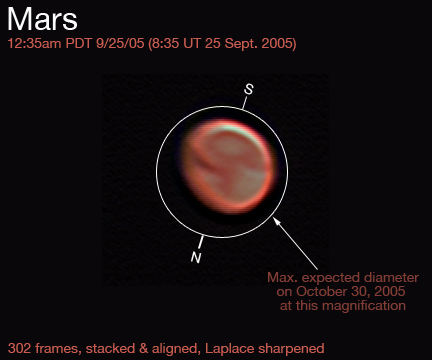
Mars, 12:35am PDT 9/25/05.
302 frames aligned & stacked, with Laplace sharpening applied.
South is up (about 2 o'clock), which makes it upside-down compared to the 2003 photos below. However, this better matches the orientation at A.L.P.O, such as http://www.lpl.arizona.edu/%7erhill/alpo/marstuff/alert/mars050917c.jpg , so I think I'll adjust them all like this this time around. I used my Unibrain firewire webcam for this picture. That circular patch is the Hellas basin center top, with Syrtis Major below it.
It's been a while since I did any astrophotography. I wanted to make sure I could still set things up before Mars came into opposition. I'd been stalling all year watching Jupiter go through opposition and now it's too late to do any Jupiter photography :-(. It'll be fun to watch Mars get bigger and fuller as it comes the closest it's been since 2003. Although not quite as close as 2003, Mars should be better placed for observation this year (higher in the Northern hemisphere sky). The best times to image Mars will be any time in the weeks leading up to October 30, 2005, when Mars is as close to Earth as it's going to get this year, continuing through the weeks following November 7, 2005, when Mars is at opposition (Sun, Earth and Mars are all in a line).
10 February 2005
I did a fairly careful alignment of the Celestron to Polaris this time, and used mirror lockup and a remote shutter on the Canon EOS 20D to minimize vibration. Unfortunately the clouds came in quite quickly and the air was probably already thick with moisture by the time I even started. The image of the Orion Nebula consists of approximately 6 frames of approximately 10 seconds each, with ISO 1600, aligned & stacked in Keith's Image Stacker. Levels adjusted and a bit of sharpening added. I still have quite a bit of experimenting to do, and it would be nice to have a clear, dark night when I have energy and time to try again. I'm surprised Saturn came out at all. By the time I took the last frame, it was shining through the clouds. It's pretty obviously overprocessed, but hey! it looks like Saturn.
4 January 2005
I got a new camera yesterday: Canon EOS 20D SLR. Tonight we had a bit of clear sky so I tried to get the Orion Nebula. I was partially successful before the clouds rolled in and the telescope fogged over.
As you can see from the closeup, there was a bit of problem with vibration, probably caused by the mirror in the camera flipping up. I'll try again next clear night to see if I can get pinpoint stars rather than wobblies by setting the mirror lockup feature.
22 May 2004
I don't think I've ever tried to photograph Venus before. I won't be on the east coast for this years rare transit of the sun, so I thought I'd take a look tonight. Unfortunately, it was already about 9pm by the time I got the scope out and Venus was low over the neighbor's house. Lots of atmospheric distortion, faithfully captured in the image.
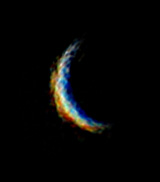
A crescent Venus. Approximately 8 images taken with Canon PowerShot G3 and stacked.
28 March 2004
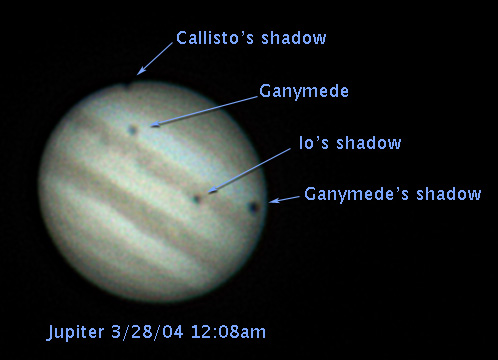
47 images stacked.
At 9pm I went to Spaceweather and they mentioned that there would be three simultaneous shadows on Jupiter at midnight - an event that only comes around about once every five years. Well, I'd never seen a shadow on Jupiter, so it sounded like the perfect opportunity. I captured all three shadows and Ganymede! Io is over the disk to the left of Io's shadow, but I can't make it out in the image.
14 March 2004
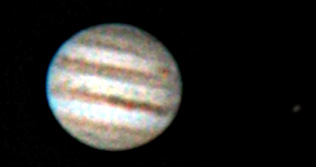
Jupiter 11 frames stacked. 8:55pm PST
I'm not sure, but I think I finally captured the red spot. Also caught Io there to the right.
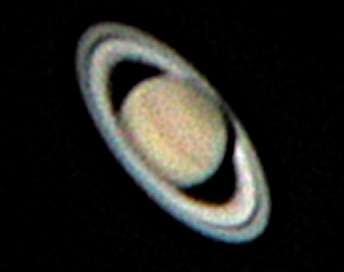
Saturn 11 frames stacked. I tried Keith's Image Stacker's "2x resampling" feature to make the image larger, and heavily overprocessed. 9:04pm PST
21 January 2004
12-13 September 2003
Three images each from many frames stacked & laplace sharpened (the last was a combination of 859 frames), taken at 11:02pm, 11:27pm and 12:12am PDT the night of September 12-13, 2003. If you can cross your eyes to get the images to merge, you can see a slightly three-d image of Mars. Or, click to see them combined into an animated GIF.
10 September 2003
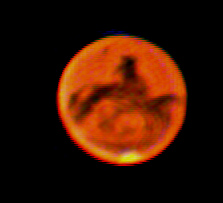
250 frames, Laplace sharpened 10:32pm PDT. Darkened a bit in Adobe PhotoShop.
6 September 2003
It was a night of experimenting. How did the Celestron compare to the Meade ETX? How much difference does it make to have the telescope well collimated? How well do my Mars photographs compare with what others are getting? And how much does it matter how many frames I combined when processing the final image? I read somewhere that the signal to noise ratio improves as the square root of the number of frames, but I wanted to see for myself how that played out. So I made two charts showing exactly what you get each time you double the number of frames, from 1 to 256. I added the 304 frame image at the end, since that's all the frames I had. Click on each of these charts for a larger version.
Before sharpening, the differences between 1 frame and 304 frames only very slightly improves with each doubling.
After sharpening, the improvement with each doubling of the frames is quite evident. Note that I have the 32 frames version twice, as I tweaked the sharpening there and wanted to show the transition. It's especially interesting to me that the obvious spot above the south pole disappears after stacking 64 or more frames.
Here's a full-size version of the last frame (or you can see full size versions of all the frames if you click on the image above):
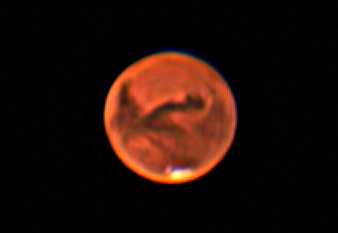
Mars is just beautiful.
Oh, and here are the results of my Celestron vs. Meade comparison. I scaled up the Meade ETX picture to match the size of the others. The third image is from http://www.lpl.arizona.edu/~rhill/alpo/marstuff/recobs.html, used without permission (this is a really cool site by the way). The last one is what my favorite astronomy program, Starry Night Pro, shows. I think it was generated from a mosaic of Viking Mars images, so the dark & light patches may no longer perfectly line up with what we see today.
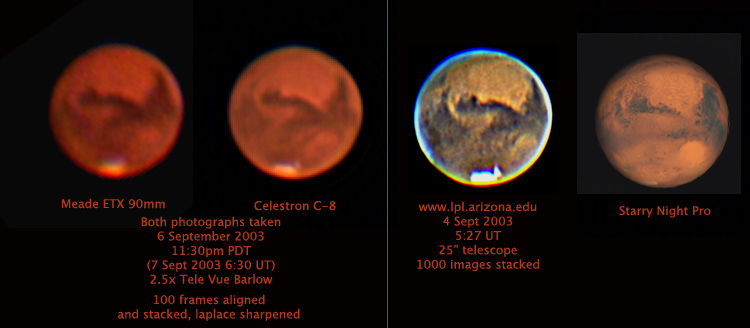
5 September 2003
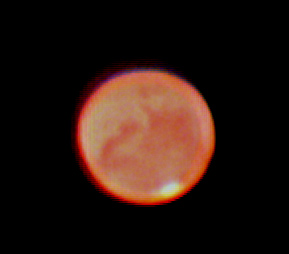
I was disappointed with this one when I first did it, but since it shows a different side of Mars than most of the others I've posted recently, I thought it would be good to add. Not sure how many frames I stacked and sharpened. Probably around 150-200. 12:42am.
31 August 2003 10:32pm
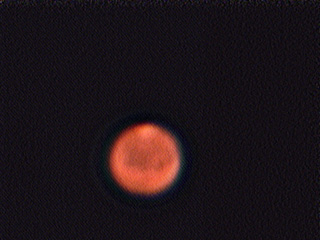 100 frames stacked, sharpened. |
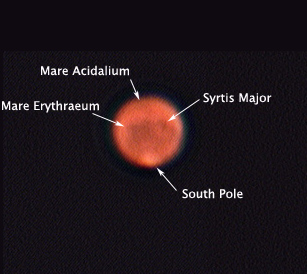 Same image, but flipped to be normal orientation and labelled so you have some idea what the dark smudges are. |
I visited a friend in Burlingame who wanted to see Mars. We set up the telescope in a court near his house where we had a good view to the southeat. Unfortunately, we didn't have a lot of time, so we didn't get a great picture. But you can still see the polar cap, and there are some nearly-recognizeable markings.
27 August 2003 11:27pm
Mars at its closest.
100 frames taken at 11:27pm PDT 8/27/03 with a modified Unibrain Fire-i webcam. Aligned, stacked and dark-frame subtracted in Keith's Image Stacker. Unsharp mask applied to bring out detail. Reduced to 50% size in Adobe Photoshop. Click on the image for more details.
20 August 2003 again
I went back and reviewed the data I had captured. Three of the movies were taken in quick succession, so I was able to combine 150 frames to produce a noticeably better Mars image.
20 August 2003
Spent the evening showing Mars to the neighbors. They enjoyed it almost as much as I did. Here are some pictures, approximately 10 minutes apart. You can almost tell that Mars is rotating. Seeing was terrible, but at least it wasn't cloudy. Click for a larger version.
17 August 2003
Another attempt at Mars. Unfortunately, the seeing was terrible and the sky was clouding over. And I was having trouble with the settings on the webcam (was Mars too bright?) Anyway, I got this fairly nice image despite the odds.
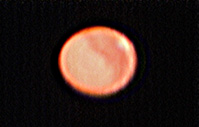
17 August 2003, 11pm PDT
8 August 2003
Okay, I took my modified Unibrain Fire-I and got my first ever picture of Mars! I could see the Polar cap (top of image) more clearly than is shown here, but this is pretty similar to what I was seeing when looking through the eyepiece.
 |
I also pointed the camera at the Moon to see what it would do.
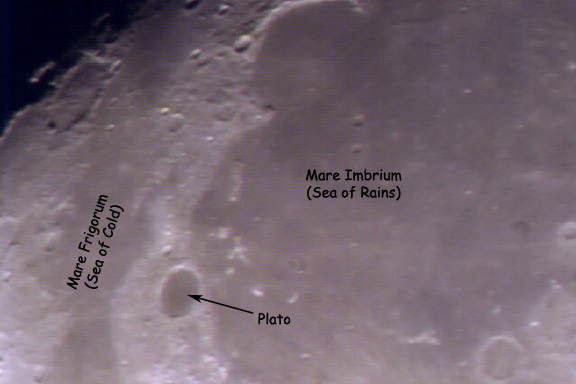
10 June 2003
Here is an attempt at Jupiter using a Unibrain Fire-I webcam at primary focus (no eyepieces, no lens on the Webcam, just a raw CCD). I took short movies using ImageDV, then stacked a subset of the best frames with Keith's Image Stacker, on Mac OS X, of course.
This was a test run in preparation for the Mars opposition. So hopefullly there will be more pictures here soon!
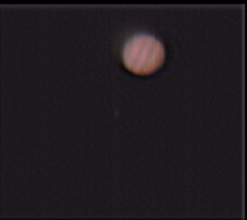
Jupiter and Io (Io is at 7 O'clock). |
Just Jupiter, but higher contrast. |
The Moon, taken using the same techniques. Applied an unsharp mask and a bit of Gaussian blur.
My Celestron 8" scope is finally getting a chance to do some photography. A neighbor had been asking to see my "big telescope" so for New Year's Eve I finally got it out of its case and pointed it at the sky. Here's what we saw...